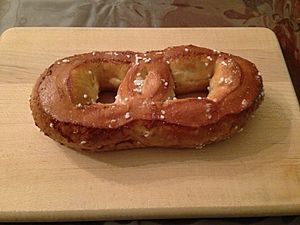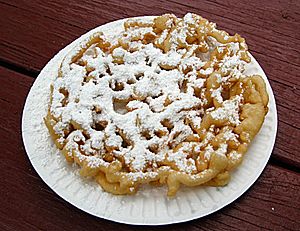Cuisine of Philadelphia facts for kids
The food of Philadelphia is special because of its many different cultures, local ingredients, and long history. Some foods are very famous and strongly connected to the city.
For example, the cheesesteak was invented in Philadelphia in the 1930s. It is probably the most well-known food from the city. Also, soft pretzels have been a big part of Philadelphia's food culture for a long time.
In the late 1800s and early 1900s, two important food markets opened: the Reading Terminal Market and the Italian Market. After a quiet time for restaurants in the mid-1900s, the 1970s brought a new burst of exciting restaurants. This growth has continued into the 21st century.
Many foods and drinks from Philadelphia are also linked to the Pennsylvania Dutch and Italian-American cuisine.
Contents
Cool Food Creations
Philadelphia has many different kinds of people, which has led to a mix of tastes and new food ideas. Many foods were created in or near Philadelphia, or they are strongly connected to the city. In the 1900s, some of these foods included the cheesesteak, stromboli, hoagie, soft pretzel, water ice, and soda.
The Famous Cheesesteak
A cheesesteak is a sandwich usually made with thin slices of beef and melted cheese on an Italian roll. It started in the 1930s when brothers Pat Olivieri and Harry Olivieri, who sold hot dogs, put grilled beef on a hot dog bun. They gave it to a taxi driver.
Later, Pat and Harry began selling the sandwich on Italian rolls. The cheesesteak became even more popular when one of their cooks added melted cheese to the sandwich.
At first, the cheese was melted separately. This was to help customers who followed certain food rules that kept dairy and meat apart. Today, you can usually choose from American, Provolone, or Cheez Whiz cheese in Philadelphia. Cheez Whiz is very popular in places that offer it.
The Hoagie Story
The hoagie is another sandwich that people say was invented in Philadelphia. It likely came from Italian-American cuisine. Some believe that Italian workers at the Hog Island shipyard in Philadelphia during World War I created the sandwich. They put different sliced meats, cheeses, and lettuce between two slices of Italian bread. This sandwich became known as the "Hog Island" sandwich, which later turned into "hoagie."
In 1992, the hoagie was named the official sandwich of Philadelphia. It's a sandwich with meat, cheese, lettuce, tomatoes, and onions on an Italian roll.
Roast Pork Sandwich
Another Italian roll sandwich popular in Philadelphia is the roast pork Italian sandwich. It's a version of an Italian street food called porchetta. This sandwich has sliced roast pork with broccoli rabe or spinach and provolone cheese.
Special Soups
The Philadelphia Pepper Pot is a soup made with tripe (part of an animal's stomach), meat, and vegetables. People say it was created during the American Revolutionary War and named after Philadelphia.
Snapper soup is a thick, brown turtle soup served with sherry. It's a special food in Philadelphia, often found in local bars and seafood restaurants. Many places serve it with oyster crackers and horseradish.

Soft Pretzels
The soft pretzel is a snack often linked to Philadelphia, even though it wasn't invented there. Soft pretzels date back to 7th-century France. They were brought to the Philadelphia area by the Pennsylvania Dutch. Many vendors sold pretzels on street corners in Philadelphia. The Federal Pretzel Baking Company helped make soft pretzels famous in the 1900s by making and selling them in large amounts.
Irish Potato Candy
Another snack from Philadelphia is Irish potato candy. These candies have a coconut cream inside, usually made from coconut, confectioner's sugar, vanilla, and cream or cream cheese. They are rolled in cinnamon on the outside, making them look like small potatoes. These treats are about the size of a large marble and are very popular around St. Patrick's Day.
Oh Ryan's, a company in Boothwyn, Pennsylvania, says it's the biggest seller of Irish Potatoes. They ship about 80,000 pounds to stores, mostly in the Philadelphia area.
Water Ice
Water ice is very popular in Philadelphia. It was brought to the city by Italian immigrants. In other Northeastern US cities, it's called Italian ice. Water ice likely comes from semi-frozen desserts from Italy, especially granita.
The Philadelphia area is the only place in the United States that calls this dessert "water ice." In other places, like New York City, it's called "Italian ice." However, some say water ice is a special type of Italian ice that started in Philadelphia. Famous stands like "Pop's" or "Italiano's" in South Philadelphia later became larger companies like "Rita's Water Ice".

Texas Tommy Hot Dog
Like New York City and Chicago, Philadelphia has its own special hot dog called the Texas Tommy. It started near Philadelphia in Pottstown, Pennsylvania and became popular throughout the Philadelphia and South Jersey areas. The Texas Tommy hot dog is known for its toppings: cheese (usually cheddar cheese) and bacon.
Some Texas Tommy hot dogs use Cheez Whiz instead of cheddar cheese, like on cheesesteaks. The bacon and cheese are often wrapped around the hot dog. The hot dog can be cooked in different ways, like deep frying, barbecuing, or grilling. You can also add mustard, ketchup, or relish.
Sometimes, chili is added to the Texas Tommy. This makes it look more like a Texas Wiener or chili dog with bacon and cheese.
Philadelphia's Sodas
Even though soda isn't only from Philadelphia, it was invented there. Popular brands that started in the city include Hires Root Beer, Franks Beverages' Black Cherry Wishniak, Vanilla Cream, and Levis Champ Cherry.
Places to Eat and Markets
In early Philadelphia, most eating places were taverns. By 1752, Philadelphia had 120 licensed taverns and many more illegal ones. These taverns were for all kinds of people, from sailors to city leaders.
Famous taverns like the London Coffee House and the City Tavern were regular meeting spots for important people. The City Tavern today is a copy of a historic 18th-century building. It serves old recipes in dining rooms that look like they did long ago.
McGillin's Olde Ale House, located on Drury Street, is the oldest tavern that has been open continuously in the city. It's also a place where you might spot famous people.
Famous Markets
In the late 1800s, many Italian immigrants moved to South Philadelphia. This led to the creation of the Italian Market. This market, along part of South 9th Street, has many food sellers and other shops. Today, many non-Italian merchants also work there.
Another market, the Reading Terminal Market, opened in 1892. It was built to replace markets that were moved when the Reading Terminal was built on Market Street in Center City. Reading Terminal Market has over 80 sellers and is a popular place for tourists. In 1902, Joseph Horn and Frank Hardart opened the first automat in the U.S. at 818 Chestnut Street. An automat was a restaurant where you got food from vending machines. The original Automat is now part of the Smithsonian Institution.
Modern Dining Scene
In the 1950s and 1960s, Philadelphia's restaurant scene was not very exciting. Many people moved to the suburbs, and fancy dining was mostly found in private clubs.
But in the 1970s, as the city grew again, Philadelphia's restaurants became popular once more. For example, in 1970, Georges Perrier opened Le Bec-Fin, which quickly became one of Philadelphia's most famous restaurants. Many new and fancy dining places opened after that, like the Fountain Restaurant in the Four Seasons hotel in 1983. Along with these upscale places, many ethnic and fast-food restaurants opened throughout the city.
The 1970s also saw more street vendors. These vendors, building on the tradition of chestnut and pretzel sellers, began selling many foods. This included hot dogs, cheesesteaks, and breakfast sandwiches. At first, there were some arguments between vendors and established stores. But now, vendors are a common sight and are even known for serving great food.
Today, Philadelphia has many different kinds of eateries. The city is known for its excellent food, and many chefs have won awards.
Popular local restaurant owners like Stephen Starr's STARR Restaurants and Iron Chef Jose Garces's Garces Restaurant Group run restaurants alongside smaller, chef-owned places where you can bring your own drinks. Major dining areas include Rittenhouse Square, Old City, Chinatown, Manayunk, East Passyunk Avenue, and Fishtown.
Philadelphians enjoy many types of food, including Italian, Mediterranean, Chinese, Japanese, steakhouses, French, gastropub food, tapas, diners, delis, and pizzerias.
In 2006, new rules were put in place for bars and restaurants in Philadelphia. These rules included a ban on smoking inside. Later, in 2007, the Philadelphia City Council also banned certain unhealthy fats in restaurants. These changes were part of efforts to help people eat healthier.
Other Foods with Philadelphia Roots
- Cheese sauce—a gooey, orange sauce that many street vendors sell. People in Philadelphia often add cheese sauce to foods like French fries and pretzels. Most of the "cheese sauce" served is the well-known brand, Cheez Whiz.
- Funnel cake—linked to the Pennsylvania Dutch. It's made by pouring batter into hot oil in a circle and frying it until golden. It's very popular in the Philadelphia area.
- German butter cake—a very rich cake with a buttery, pudding-like center. It's also called Philadelphia Butter Cake.
- Good & Plenty—a popular licorice candy created in 1893.
- Herr's—a snack brand from the Philadelphia area, known for potato chips and other snacks.
- Peanut Chews—a popular candy made in Philadelphia since 1917.
- Pork roll—even though it was developed and mostly made in Trenton, New Jersey, pork roll is widely available in Philadelphia and is a common part of the city's food.
- Roast pork sandwich—usually served on an Italian roll, often with broccoli rabe instead of spinach, and most traditionally with sharp provolone cheese. It's a main food in South Philadelphia.
- Scrapple—a processed meat loaf made from pork scraps mixed with cornmeal and flour. It's a breakfast food from Pennsylvania.
- Soda—in the early 1800s, Dr. Philip Syng Physick and John Hart of Philadelphia invented carbonated water. In 1807, a Philadelphia pharmacist named Townsend Speakman sold fruit juice and carbonated water, creating the first soft drink. In 1875, Charles Elmer Hires invented root beer by mixing different flavors. He sold it at his drug store in Philadelphia.
- Whoopie pie—also linked to the Pennsylvania Dutch. It's made of two round pieces of chocolate cake (or sometimes pumpkin or gingerbread cake) with a sweet, creamy filling in between. It's also popular in New England.
- Spiced wafers—a type of cookie traditionally sold in the autumn.
- Stromboli—said to have started in 1950 in Essington, just outside Philadelphia. It's a type of turnover made with Italian bread dough filled with different kinds of cheese, Italian meats, or vegetables. Panzarotti is a special name for a deep-fried stromboli, especially popular in Philadelphia's South Jersey suburbs.
- Tastykake—the most famous snack brand from Philadelphia. Since 1914, the Tasty Baking Company has made packaged baked goods for the region. Well-known items include Krimpets, cupcakes, Kandy Kakes, and Tasty Pies.
- Tomato pie—basically a pizza without cheese, usually large, with extra oregano. Tomato pie is normally served cold or at room temperature. It's often found in Northeast Philadelphia and at bakeries in South Philadelphia.
- Texas Tommy—a grilled, split hot dog with bacon and cheese. It's a common hot dog dish in Philadelphia.
- Water ice—a version of Italian ice that is popular in Philadelphia and the Delaware Valley. It's sold fresh at special shops and also pre-packaged in grocery stores.


















